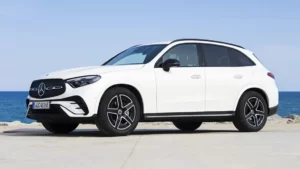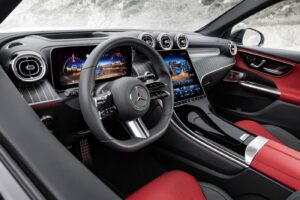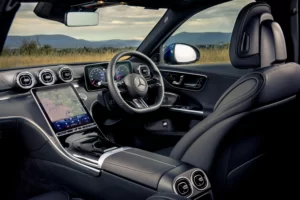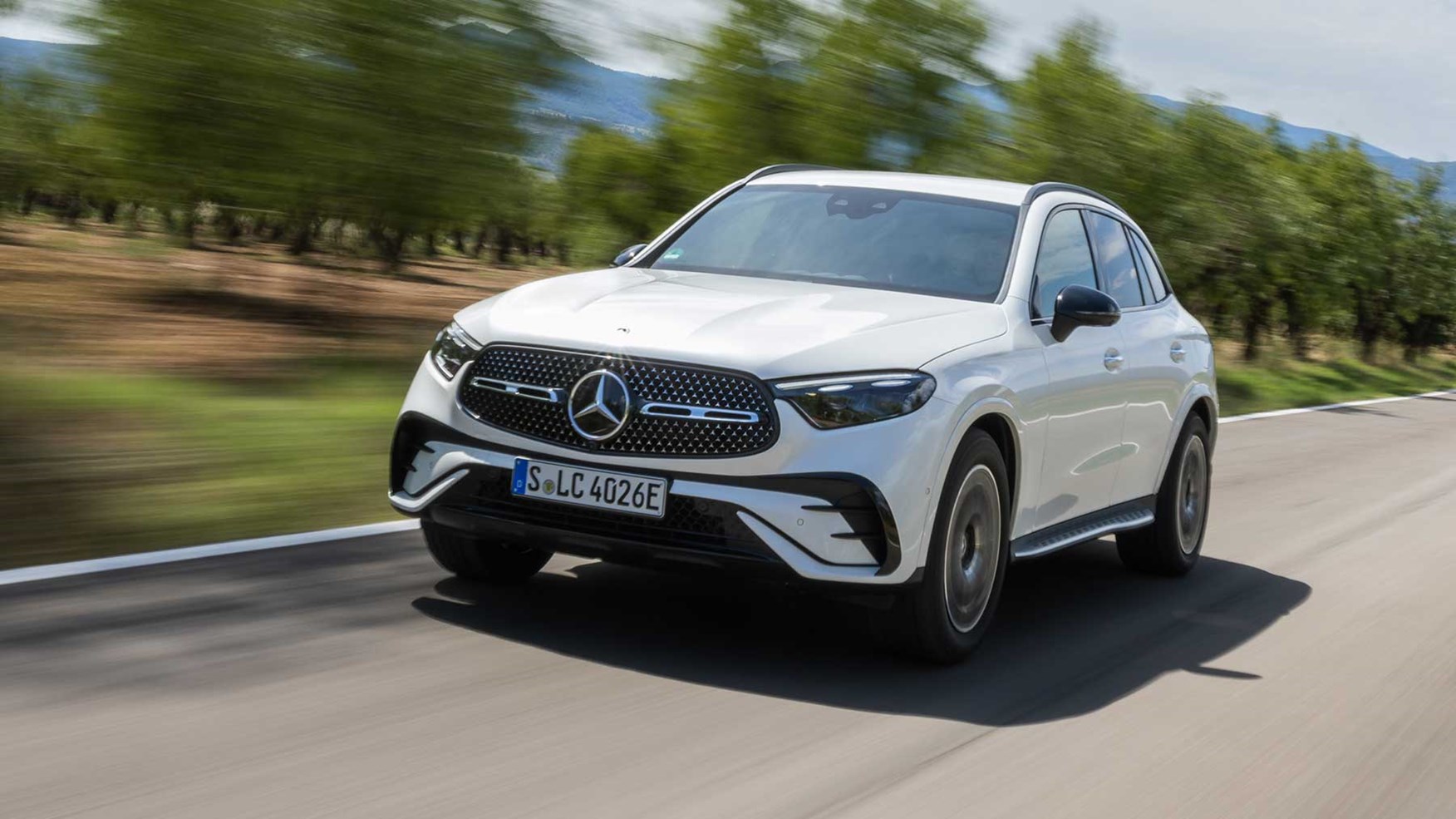Mercedes-Benz’s third-generation GLC300 compact SUV proves that luxury and value don’t have to be mutually exclusive ideas.

The Mercedes-Benz GLC300 returns for its 2023 model year with a completely redesigned interior and exterior with more cargo space, a new powertrain, and standard equipment that collectively can’t be found across its three primary competitors, the BMW X3 xDrive30i, Audi Q5 45, and Lexus RX350. On top of the desirable base model, the optional Exclusive and Pinnacle trims are still in the realm of affordable, and all three versions of the GLC300 should put this this midsize SUV’s into proper contention.
The 2023 GLC300 comes with a new 2.0-liter turbocharged four-cylinder producing 255 hp and 295 lb-ft of torque—up 22 lb-ft over its predecessor. A 48-volt mild hybrid system is now standard with the motor sandwiched between the engine and the nine-speed automatic transmission. It can pitch in bursts of 23 hp and 148 lb-ft of electric boost, though the new GLC300 is no quicker than the outgoing model. With the available 4Matic all-wheel drive, this combination propelled our GLC to 60 mph in 5.6 seconds, completing a quarter-mile run in 14.2 seconds. The 2020 GLC300 4Matic made the same runs in 5.4 and 14.1 seconds. What gives? The 2023 model weighed in 479 pounds heavier than the previous generation that we tested.
The 48-volt motor boosts power only intermittently. In our quarter-mile times and normal highway passing manoeuvres, sometimes it came in, sometimes it didn’t. We couldn’t discern a pattern or condition that caused it to activate, and you’ll likely only notice when you see the “Boost Active” message on the digital gauge cluster rather than feeling it. The system does at least deliver an increase in fuel economy with the all-wheel-drive model’s combined rating now landing at 26 mpg, up from 24 mpg.
Our test vehicle came equipped with the optional AMG Line package, which gave it perforated front brake discs, and 20-inch AMG wheels wrapped with high-performance summer tires, bizarrely named Continental EcoContact. Impressively, the GLC300 managed an average lateral acceleration of 0.87 g on the skidpad and completed our figure-eight course in 26.7 seconds with an average of 0.71 g. The upgraded rotors brought it from 60 mph to a stop in 109 feet. It might not be the quickest SUV you’ll ever drive, but it isn’t marketed as a dedicated performance model (an AMG model is inevitable, but there’s no release date yet), and it weighs 4,372 pounds. That’s respectable performance we attribute to the upgraded brakes, the tires, and the fine-tuning of the transmission, steering, and throttle in Sport mode. Other drive modes on the GLC300 include Eco, a customizable Individual, and Offroad available on 4Matic models.
The new exterior stretches the vehicle 2.4 inches and keeps the width of the body unchanged. The extra length contributes to an extra 2.5 cubic feet of cargo space for a total of 21.9 cubic feet. It’s an improvement but still far below the 29.6 cubic feet of the 2023 Lexus RX. Mercedes-Benz emphasises the effort engineers and designers put into reworking the shape and position of the mirrors as an effort to reduce the drag coefficient from 0.31 to 0.29. The redesigned front end and body contours contribute to the improved aerodynamics while modernising the overall look of the GLC300. The result of all this body sculpting is improved fuel economy and an incredibly quiet interior. The standard laminated windshield, insulated hood, and acoustic-foam-filled body reduce noise, as well (at the expense of added weight). For an even quieter ride, the Pinnacle package includes glass treated for acoustic and heat insulation all around. Mercedes-Benz didn’t quantify the noise reduction, but subjectively it is remarkably quiet. We complained about the coarse engine noise in the outgoing GLC300. The new engine clatters like a diesel still, but the noise is largely kept out of the cabin. You’ll likely only notice it with the windows open.

The new GLC300 packs a lot of value into its standard offerings. It comes with an 11.9-inch center touchscreen and a 12.3-inch digital instrument cluster. Wireless phone charging and wireless phone mirroring with Android Auto and Apple CarPlay come standard, along with heated front seats, keyless start, keyless passive entry, 40/20/40 folding rear seats, a sunroof, and ambient lighting with 64 colours. Buyers should find no shortage of power with three USB-C charging ports standard, with the option to upgrade to six 100-watt USB-C charging ports.
As part of the new driver assist features, the 2023 GLC300 has the ability to read overhead signs and interpret conditional warnings like slower speeds when wet or construction speed limits. It definitely does this, but somewhat inconsistently and abruptly. Entering a construction zone, the GLC300 braked too quickly for a non-emergency situation—hard enough that other drivers might think you’re giving them a brake-check. The adaptive speed control works well, and if it could react to conditional speed limits as naturally, it would be a better feature. Sometimes it would miss signs in an active construction zone, and other times it would scrub 30 mph of speed hard in a zone that clearly was not active anymore.

The Sport driving mode makes the GLC extremely responsive and does make it more fun to drive. However, in any driving mode, the initial pedal response is too slow from a stop. Whether you’re pulling away gently or with the accelerator floored, the vehicle creeps forward for a second or two before actually taking off. It isn’t slow enough to be dangerous, but it takes away from the performance feel.
Our Verdict
Overall, the 2023 GLC300 provides an incredible value at any trim level, with an impressive list of standard equipment. At a starting price of $48,250 for the rear-wheel-drivel model and $50,250 for the 4Matic, it starts slightly higher than the BMW X3 xDrive30i but less than the Lexus RX350. The Audi Q5 45 comes standard with Quattro all-wheel drive at a lower starting price, but its standard equipment still doesn’t quite match up. We hate to refer to a luxury vehicle as a bargain, but this one really is. Mercedes-Benz made enough equipment standard that the base model is actually a viable option. Our $62,750 GLC300 was an Exclusive model fitted with AMG Line and Night appearance packages and felt richer than the price tag. It’s not often we say that about new vehicles these days.
source: motortrend




